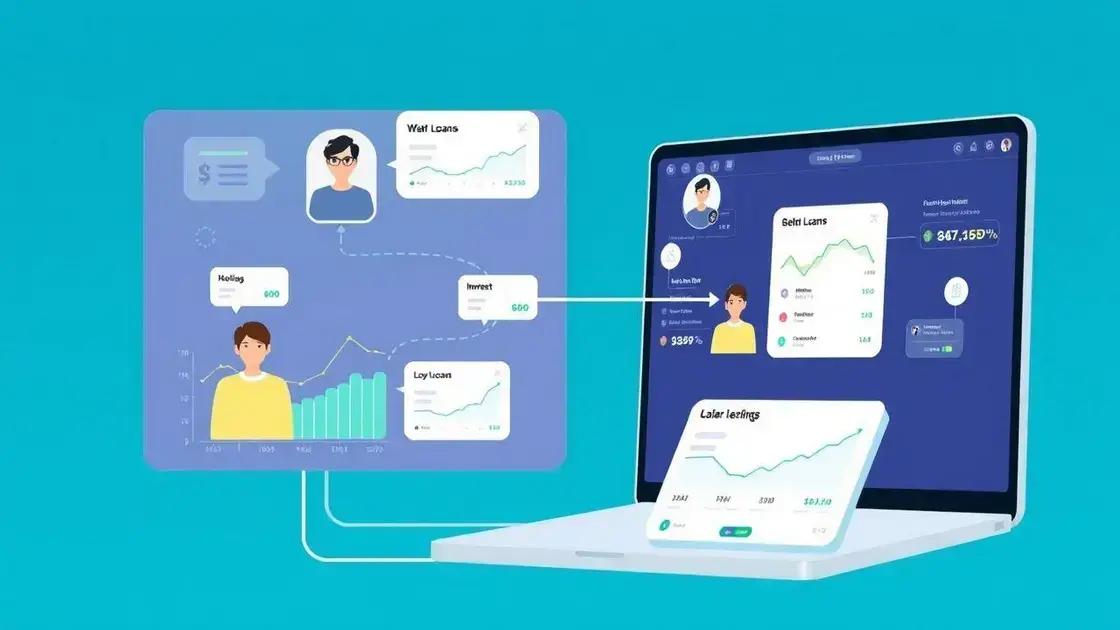Fintech innovations disrupt traditional credit markets

Fintech innovations disrupt traditional credit markets by streamlining the lending process, enhancing credit evaluations through blockchain, and presenting significant challenges for banks to adapt to new consumer demands.
Fintech innovations disrupt traditional credit markets, transforming how consumers access loans and credit. Have you wondered how these changes affect you? Let’s dive into this exciting evolution.
Understanding fintech’s impact on credit systems
Fintech is reshaping how we think about credit. With technology at the forefront, many consumers find new paths to loans that were once difficult to navigate.
Understanding fintech’s impact on credit systems requires looking at several key factors. How have startups changed the landscape? They offer flexibility and personalization that traditional banks might not. For instance, automated systems evaluate creditworthiness instantly without relying on outdated methods.
How fintech simplifies borrowing
This innovative approach appeals to both borrowers and lenders. Consumers experience a faster process, while lenders benefit from a wider pool of applicants. Additionally, the greater transparency in transactions creates trust between parties.
- Instant credit decisions
- Customized loan options
- Reduced fees and costs
- Accessibility for underserved markets
Moreover, fintech companies leverage data analytics to assess risk more effectively. Traditional banks often rely on credit scores alone, while fintech can dive deeper. By analyzing various data points, they paint a more comprehensive picture.
This leads to a more inclusive system where individuals with non-traditional financial histories can access credit more easily. In the end, it promotes competition, resulting in better offers for everyone.
The rise of peer-to-peer lending

The emergence of peer-to-peer lending has revolutionized the way individuals and businesses access credit. This new model cuts out traditional banks, allowing borrowers to connect directly with lenders. It provides a fresh alternative that many find appealing.
By participating in peer-to-peer lending, individuals can expect better interest rates. Since loans are funded by personal investors, borrowers often save money compared to traditional loans from banks. Additionally, this system allows lenders to earn competitive returns on their investments by funding loans directly.
Benefits of peer-to-peer lending
This method of lending offers numerous advantages for both parties involved. For borrowers, it presents a faster and more straightforward application process. Lenders enjoy the ability to choose which loans they want to fund, aligning with their risk preferences.
- Lower interest rates for borrowers
- Higher returns for lenders
- Greater accessibility for those with less-than-perfect credit
- Transparency in loan terms and conditions
Moreover, peer-to-peer lending platforms often utilize advanced technology for risk assessment. This process enhances the overall efficiency of loans. Users enjoy convenience through online platforms that operate 24/7, enabling them to manage their investments or borrowings at any time.
As more consumers become aware of these platforms, their popularity continues to grow. Many peer-to-peer lending services have emerged, reflecting a strong demand for flexible financing options. This trend is reshaping the credit landscape, putting more power in the hands of the people.
Blockchain technology’s role in credit evaluation
Blockchain technology is transforming credit evaluation by enhancing transparency and security in lending practices. This innovative solution allows for decentralized data storage, removing the need for centralized authorities, which significantly speeds up the evaluation process.
In a traditional setup, credit evaluation can be tedious and involves multiple parties. With blockchain, information about borrowers can be securely shared among lenders without risking data integrity. This leads to quicker decisions and a more streamlined lending experience.
How blockchain improves credit assessments
By utilizing blockchain, lenders can access a comprehensive history of borrower transactions. This approach not only makes evaluations faster but also more accurate. The decentralized nature of blockchain ensures that data cannot be altered without consensus, creating a trustworthy environment.
- Enhanced data security
- Faster loan processing times
- Improved accuracy in credit scores
- Access to a broader range of financial history
This technology also allows for real-time updates, meaning that any changes in a borrower’s financial status can be quickly reflected in their credit profile. As a result, borrowers with fluctuating credit situations have a better chance of receiving fair evaluations. Overall, blockchain is aiding in the creation of a more equitable lending landscape.
The future of credit evaluation will likely see even more integration of blockchain technology, paving the way for innovations that push traditional boundaries. As more stakeholders recognize its advantages, this technology will play a crucial role in the evolution of credit markets.
Challenges faced by traditional banks in adapting

Traditional banks are facing significant challenges in adapting to the rise of fintech innovations. As technology continues to evolve, these banks must compete with new providers that offer faster and more efficient services. One major challenge is transforming outdated systems that are not equipped to handle modern demands.
Many banks rely on legacy technology, which can hinder their ability to innovate. This not only affects their operations but also impacts customer satisfaction. Consumers today expect quick responses and seamless digital experiences, which traditional banks struggle to deliver.
Key challenges for traditional banks
Aside from technology, regulatory compliance adds another layer of difficulty. Banks must ensure they meet all requirements to avoid penalties. Fintech companies, however, often operate in a more flexible regulatory environment, allowing them to be more agile.
- Integration of new technologies
- Maintaining customer trust in a digital world
- Navigating complex regulations
- Competing with innovative fintech solutions
Moreover, traditional banks face difficulty in attracting younger customers. This demographic often prefers using mobile apps and online platforms over visiting brick-and-mortar locations. To bridge this gap, banks need to develop user-friendly digital interfaces that cater to modern preferences.
In addition, managing data security and privacy is crucial. As banks migrate to digital systems, they must invest in cybersecurity measures to protect customer information. Without robust security, banks risk losing consumer trust, which is essential for their survival in an increasingly digital landscape.
FAQ – Questions about the impact of fintech innovations on credit markets
How is fintech changing the lending process?
Fintech is streamlining the lending process by connecting borrowers directly with lenders, allowing for faster approvals and better rates.
What role does blockchain play in credit evaluation?
Blockchain enhances credit evaluation by providing secure and transparent access to financial histories, improving trust between borrowers and lenders.
What challenges do traditional banks face from fintech companies?
Traditional banks struggle with outdated technology, regulatory compliance, and competition for younger customers who prefer digital services.
Are peer-to-peer lending platforms safe for borrowers?
Yes, many peer-to-peer lending platforms implement robust security measures and transparency, making them a safe option for borrowers.






